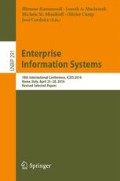Abstract
Web-mediated conversations require treating intentions more explicitly. Literature lacks adequate design methods and interactive mechanisms to support users in the sharing of intentions. This research assumes that icons representing emotions play a central role as means for aiding users to convey intentions in communication tasks. This article proposes a method to specify emoticons for representing the users’ intentions, named “intenticons”. The work explores Speech Act Theory and Semiotics in a conceptual framework to structure classes of intentions. We conduct participatory activities to experiment the method with 40 users. The obtained intenticons were evaluated with a different set of users to reveal their effectiveness. The obtained results suggest the feasibility of the method to select and enhance emoticons for intention expression. Evaluations point out that most of the achieved intenticons indicate an acceptable degree of representativeness for the intention classes.
Access this chapter
Tax calculation will be finalised at checkout
Purchases are for personal use only
References
Carretero, M., Maíz-Arévaloa C., Martíneza M.A.: An analysis of expressive speech acts in online task-oriented interaction by university students. In: 32nd International Conference of the Spanish Association of Applied Linguistics (AESLA), pp. 186–190 (2015)
Derks, D., Fischer, A.H., Bos, A.E.R.: The role of emotion in computer-mediated communication: a review. Comput. Hum. Behav. 24, 766–785 (2008)
Dresner, E., Herring, S.C.: Functions of the nonverbal in CMC: emoticons and illocutionary force. Commun. Theor. 20, 249–268 (2010)
Hornung, H., Baranauskas, M.C.C.: Towards a conceptual framework for interaction design for the pragmatic web. In: Jacko, J.A. (ed.) HCI 2011. LNCS, vol. 6761, pp. 72–81. Springer, Heidelberg (2011). doi:10.1007/978-3-642-21602-2_8
Hornung, H., Pereira, R., Baranauskas, M.C.C., Bonacin, R., Dos Reis, J.C.: Identifying pragmatic patterns of collaborative problem solving. In: IADIS International Conference WWW/Internet, Madrid, Spain, pp. 379–387 (2012)
Huang, A.H., Yen, D.C., Zhang, X.: Exploring the potential effects of emoticons. Inf. Manag. 45(7), 466–473 (2008)
Jensen, C.J., Dos Reis, J.C., Bonacin, R.: An interaction design method to support the expression of user intentions in collaborative systems. In: Kurosu, M. (ed.) HCI 2015. LNCS, vol. 9169, pp. 214–226. Springer, Cham (2015). doi:10.1007/978-3-319-20901-2_20
Liu, K., Li, W.: Organisational Semiotics for Business Informatics. Routledge, Abingdon (2014)
Luor, T., Wu, L., Lu, H., Tao, Y.T.: The effect of emoticons in simplex and complex task-oriented communication: an empirical study of instant messaging. Comput. Hum. Behav. 26, 889–895 (2010)
Peirce, C.S. Collected Papers. Cambridge. Harvard University Press, Harvard University Press (1931–1958)
Rocha, H.V., Baranauskas, M.C.C.: Design e Avaliação de Interfaces Humano-Computador. NIED/UNICAMP, Campinas (2003)
Searle, J.R.: Speech Acts: An Essay in the Philosophy of Language. Cambridge University Press, Cambridge (1969)
Thoresen, T.H., Andersen, H.M.: The Effects of Emoticons on Perceived Competence and Intention to Act. BI Norwegian Business School (2013)
Urabe, Y., Rzepka, R., Araki, K.: Emoticon recommendation for Japanese computer-mediated communication. In: IEEE Seventh International Conference on Semantic Computing, pp. 25–31 (2013)
Acknowledgment
We thank the São Paulo Research Foundation (FAPESP) (Grant #2014/14890-0) and National Counsel of Technological and Scientific Development (CNPq) (Grant #308618/2014-9). We also thank colleagues from the InterHAD research group for the insightful discussions. The opinions expressed in this work do not necessarily reflect those of the funding agencies.
Author information
Authors and Affiliations
Corresponding author
Editor information
Editors and Affiliations
Rights and permissions
Copyright information
© 2017 Springer International Publishing AG
About this paper
Cite this paper
Dos Reis, J.C., Jensen, C.J., Bonacin, R., Hornung, H., Calani Baranauskas, M.C. (2017). Participatory Icons Specification for Expressing Intentions in Computer-Mediated Communications. In: Hammoudi, S., Maciaszek, L., Missikoff, M., Camp, O., Cordeiro, J. (eds) Enterprise Information Systems. ICEIS 2016. Lecture Notes in Business Information Processing, vol 291. Springer, Cham. https://doi.org/10.1007/978-3-319-62386-3_19
Download citation
DOI: https://doi.org/10.1007/978-3-319-62386-3_19
Published:
Publisher Name: Springer, Cham
Print ISBN: 978-3-319-62385-6
Online ISBN: 978-3-319-62386-3
eBook Packages: Computer ScienceComputer Science (R0)

